Essential oils have been around for centuries, used for their therapeutic benefits and delightful fragrances. However, the question arises whether a water distiller can be used for extracting essential oils, and if so, what’re the benefits and drawbacks of doing so. We will also address any concerns or potential issues associated with this method and provide tips on how to ensure optimal results when using a water distiller for essential oils.

Can You Mix Essential Oils With Distilled Water?
However, it’s important to note that essential oils and water don’t mix well on their own, and therefore, it’s necessary to use a dispersant or emulsifier to create a stable mixture. Without a dispersant, the oils can separate from the water and form a layer on top, making it difficult to use.
One popular dispersant is alcohol, which not only helps to distribute the oils evenly in the water but also acts as a preservative, extending the shelf life of the mixture. However, some people may find the use of alcohol irritating to their skin or respiratory system and may prefer to use other options such as vegetable glycerin, witch hazel, or aloe vera gel.
Before mixing any essential oils with water, it’s important to consider the safety and suitability of each oil for the intended use. Some oils may not blend well with water or may cause skin irritation or allergic reactions when combined with certain substances. It’s also important to dilute the oils properly, following recommended guidelines based on the age, health, and sensitivity of the person using the mixture.
Once you’ve selected the right oils and dilution ratios, you can easily create your own spray, mist, or room diffuser by mixing the oils with distilled water and a dispersant of your choice. A simple recipe for a relaxing lavender mist, for example, might include 10-15 drops of lavender essential oil, 1 tablespoon of alcohol or witch hazel, and 4 ounces of distilled water, mixed together in a spray bottle.
Overall, mixing essential oils with distilled water can be an effective and easy way to enjoy the many benefits of aromatherapy. With proper research, preparation, and caution, you can create your own customized blends that promote health, wellness, and relaxation. Whether you’re looking to soothe a headache, boost your mood, or freshen up your home, essential oils and water can be a powerful combination.
Using Essential Oils and Distilled Water in Skincare and Haircare
Essential oils and distilled water are natural ingredients that are commonly used in skincare and haircare products due to their numerous benefits. They can moisturize and nourish the skin and hair, reduce inflammation, and even promote healing. Essential oils can be mixed with distilled water to create a refreshing mist that can be sprayed onto the face or hair for a quick pick-me-up. Additionally, they can be added to creams, lotions, and shampoos for a more targeted approach to specific concerns. Overall, using essential oils and distilled water in skincare and haircare is a great way to achieve healthy, radiant skin and hair.
It’s common for people to question why they can’t use distilled water in their essential oil diffusers. Even though distilled water may seem like the better choice, it’s actually not recommended for certain diffusers. The type of water you use in your diffuser can greatly impact it’s performance, and it’s important to follow the manufacturer’s instructions to ensure optimal results. Read on to learn more about why using tap water over distilled water can be beneficial for your essential oil diffuser.
Why Can’t I Use Distilled Water in My Diffuser?
Distilled water is stripped of all minerals, making it too pure and lacking the necessary minerals for optimal diffusion. The minerals in tap water can also help to prolong the life of your diffuser as they act as a natural lubricant that reduces friction and wear and tear on the machine. Using distilled water can cause the diffuser to malfunction or produce less visible vapor, and may also cause the diffuser to clog and require frequent cleaning.
Another reason why distilled water isn’t recommended for use in essential oil diffusers is that it can affect the scent of the essential oil. This can result in weaker or less effective scent diffusion, making the diffuser less effective overall.
Some diffusers are designed to shut off when the water level gets too low, and using distilled water can cause the machine to malfunction and fail to turn off when necessary. This can result in a fire or other safety hazard, as well as damage to the diffuser.
Additionally, it’s important to always follow the manufacturers instructions when using any essential oil diffuser to ensure that you’re using it correctly and safely.
Essential Oils vs Fragrance Oils – What Is the Difference?
- Essential oils are concentrated plant extracts, while fragrance oils are synthetic or artificially created scents.
- Essential oils are often used for their therapeutic properties and may have potential health benefits, while fragrance oils are primarily used to add scents to products.
- Essential oils are generally more expensive than fragrance oils due to the extraction process.
- When purchasing oils for use in aromatherapy or other therapeutic applications, it’s important to choose high-quality, pure essential oils.
- Fragrance oils are a cost-effective way to add scents to candles, soaps, and other products.
However, while steam distillation is popular and effective, it may not always be the best method for extracting essential oils. Other distillation techniques, such as hydro-distillation and cold pressing, have their own unique advantages that may be better suited to particular plant materials and desired end products. In this article, we will explore the various distillation methods for essential oils and their pros and cons.
What Is the Best Distillation Method for Essential Oils?
The resulting steam and volatile oils then pass through a cooling system, where the steam condenses into water, separating the essential oil from the water and allowing it to be collected. This method is effective for a wide range of plant materials, including flowers, leaves, stems, roots, and bark.
Another distillation method for essential oils is hydrodistillation. This type of distillation involves boiling the plant material in water to vaporize the essential oils. The steam and oils are then condensed and separated. While hydrodistillation is an effective method for some plant materials, it can be less efficient than steam distillation and may result in a lower yield of essential oils.
A third option for distillation of essential oils is called cold pressing. This method is typically used for citrus fruits, where the oils are found in the peel. The fruit is mechanically pressed to release the oils, which are then separated from the juice. While this method can be effective for certain plant materials, it isn’t suitable for all essential oil extractions.
CO2 extraction is another popular method for extracting essential oils. This technique involves pressurizing carbon dioxide until it reaches a supercritical state, wherein it’s able to act as both a gas and a liquid. The supercritical CO2 is then passed over the plant material, allowing it to extract the essential oils. This method is often used for delicate plant materials that may be damaged or degraded by heat.
Comparing the Yields and Quality of Essential Oils Obtained Through Different Distillation Methods.
- Steam distillation
- Hydrodistillation
- Expression method
- Cold press method
- Solvent extraction
For those interested in making their own lavender oil at home, the process of distillation may seem intimidating at first. However, with a few basic steps, it’s possible to extract the essential oil from the plant material using simple equipment and some patience. Read on to learn the basic steps of essential oil distillation.
How Do I Distill Lavender Oil at Home?
Distilling lavender oil is a simple process that can be done at home with the right equipment. The first step is to gather the fresh lavender blossoms from your garden or purchase them from a reputable source. Once you’ve your plant material, you’ll need a still. You can purchase a still online or make your own with basic household items. A still is a device used to distill essential oils from plants.
Next, you’ll need to boil water under your plant matter in the still. This will produce steam that will rise through the plant material and carry the essential oil vapor with it. As the steam rises, it will travel into a condenser tube, which cools and condenses the vapors back into liquid form. The resulting liquid will contain both the essential oil and water from the plant material.
To collect the essential oil, you’ll need to separate it from the water. This can be done by pouring the liquid into a separatory funnel or by using a pipette to carefully remove the oil layer. The remaining liquid is now hydrosol, which can also be used for aromatherapy, skincare, and other purposes.
It’s important to note that not all plant material will yield essential oils. Lavender is a popular choice for home distillation because it’s easy to grow and produces a high yield of essential oil. Other plants, such as citrus, may require more specialized equipment or a different distillation method.
It allows you to connect with nature and create your own natural products for personal use or gifts. With some basic equipment and a little patience, anyone can learn how to make their own essential oils. Just be sure to follow safety guidelines and use caution when handling hot liquids and equipment.
This process allows for the essential oil to separate from the water and be collected in a separate container. Not only is this method simple and accessible, but it also ensures that the essential oil you produce is of high quality and purity. In this article, we will dive deeper into the distillation process and explore different ways you can make essential oils at home.
What Is the Easiest Way to Make Essential Oils at Home?
As the vapour cools down, it turns back into liquid and collects in a separate container. The liquid that’s collected is your essential oil. This process may seem complicated, but it’s actually quite simple and can be done at home with just a few simple tools.
One of the most important tools youll need for making essential oils at home is a distillation kit. There are many different kinds of distillation kits available, ranging from small, simple ones to larger, more complex kits. Youll need to choose a kit that’s right for the plant you want to make the essential oil from.
First, youll need to prepare the plant material by chopping it into small pieces. This will help to release the oils from the plant.
Next, youll need to heat the plant material in your distillation kit. As the plant material heats up, the steam will rise up the narrow pipe and into the cool water. This will cause the steam to cool down and turn back into liquid, which will collect in a separate container.
After the distillation is finished, you can filter the essential oil to remove any impurities. This will help to ensure that your oil is pure and safe to use. Once you’ve filtered the oil, you can store it in a dark glass bottle to protect it from light and air.
DIY Recipes for Using Essential Oils in Daily Life
- Add a few drops of lavender oil to your laundry to make your clothes smell amazing
- Mix peppermint oil with water in a spray bottle and use it as a natural insect repellent
- Combine tea tree oil with a carrier oil (such as coconut oil) and use it as a natural acne treatment
- Add a few drops of lemon oil to your water for a refreshing and cleansing drink
- Create a relaxing bath by adding a few drops of chamomile or eucalyptus oil to your bathwater
- Use a mix of essential oils (such as lavender, peppermint, and eucalyptus) to make your own homemade vapor rub
- Combine cinnamon oil with a carrier oil and use it as a natural insect repellent
- Make your own DIY room spray by mixing your favorite essential oils with water and alcohol
- Add a few drops of rosemary oil to your shampoo or conditioner for healthier hair
- Combine frankincense oil with a carrier oil and use it as a natural anti-aging serum
While hydrodistillation and steam-distillation are popular methods for extracting essential oils, they come with their own set of drawbacks that shouldn’t be overlooked. One such method, water distillation, has been known to pose several disadvantages that can potentially affect the quality of the final product. In this article, we take a closer look at the disadvantages of water distillation and explore alternative methods for extracting essential oils.
What Are the Disadvantages of Water Distillation of Essential Oils?
Water distillation is one of the common methods used in the extraction of essential oils from plants. This process has some disadvantages that make it less desirable compared to other methods. Firstly, water distillation can lead to the thermal decomposition of extracts. This is especially true for heat-sensitive compounds which may be lost due to the high temperature required for distillation. This can lead to a reduced yield or lower quality of the resulting essential oil.
Secondly, water distillation can lead to the contamination of extracts with solvent or solvent residues. The use of contaminated water can also contribute to this problem. This can pose a health hazard to consumers of the essential oils. The presence of chemical residues in essential oils can also affect the fragrant and therapeutic properties of the oil.
Thirdly, water distillation generates large amounts of residual vegetal material, which can be an environmental problem. These residues aren’t easily biodegradable and can accumulate in the environment. This can lead to soil and water pollution. This problem is further compounded by the fact that water is an essential resource and it’s use in this process can lead to shortages in areas where water is scarce.
These issues can be addressed by using other methods like steam or solvent extraction that have fewer or no drawbacks.
Conclusion
While it may seem like a simple solution to extract oils, it’s imperative to analyze the impact of the extraction method on the quality and purity of the essential oils. It’s important to evaluate the distillation process, temperature control, and the materials used to determine if they meet the standard requirements for essential oil production. While it may initially seem like a cost-effective and easy solution, it’s important to prioritize the safety and efficacy of the essential oils produced through the distillation process.





